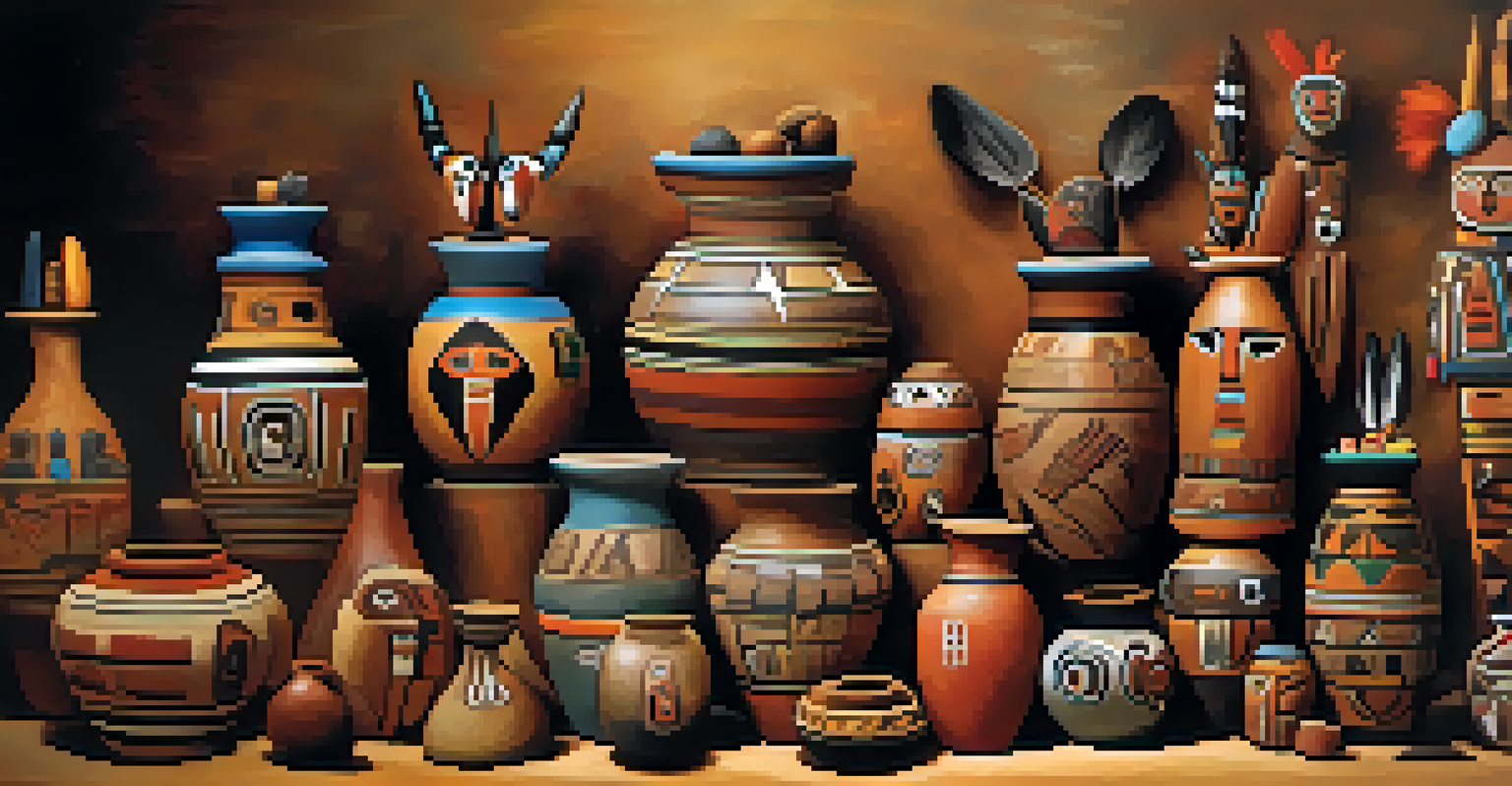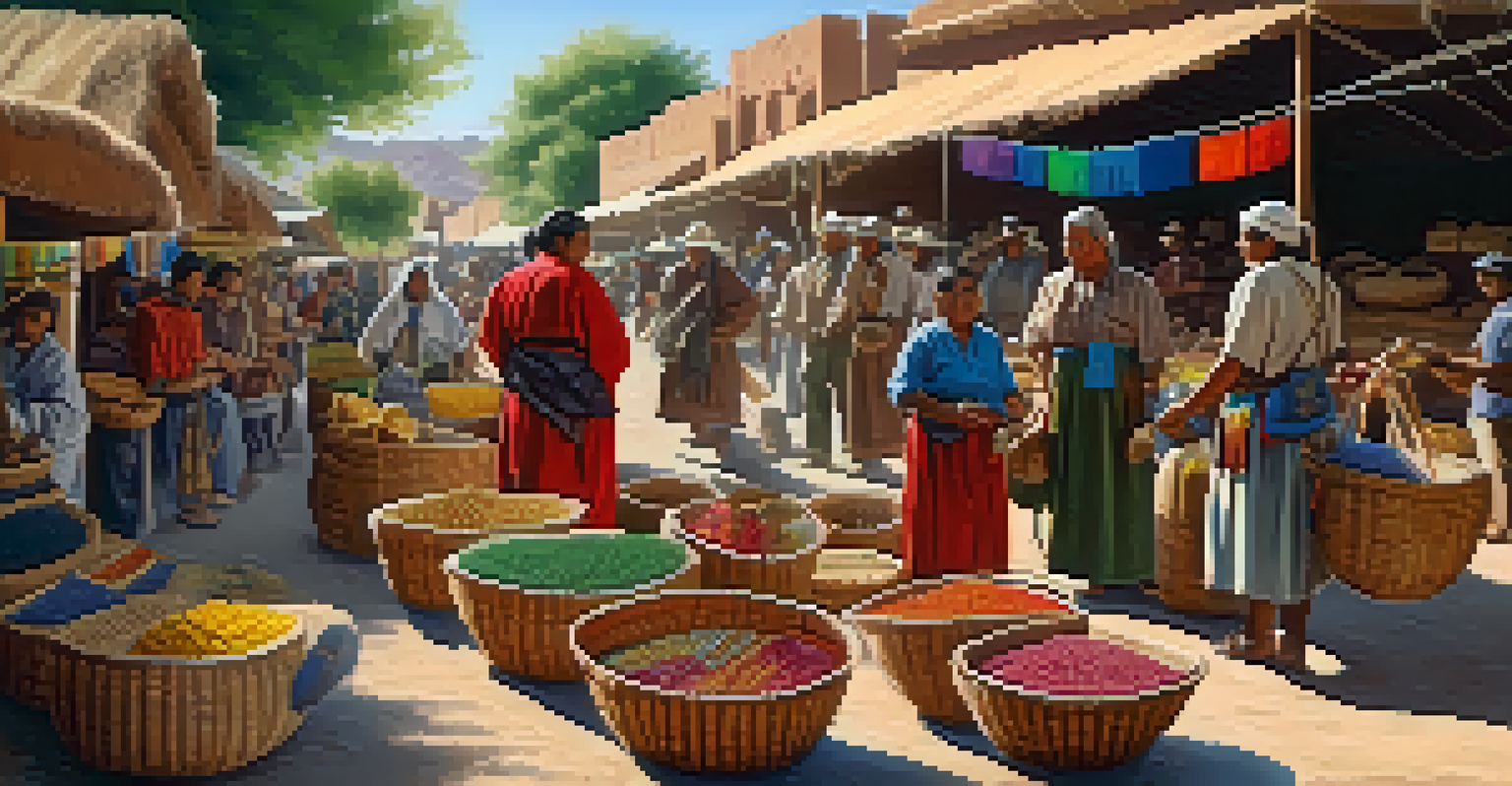Indigenous Tribes of Arizona: Their Influence on the Southwest

Overview of Indigenous Tribes in Arizona
Arizona is home to a diverse array of Indigenous tribes, each with unique cultures and histories. The most prominent include the Navajo, Hopi, Apache, and Zuni tribes. These tribes have lived in the region for thousands of years, and their traditions are deeply intertwined with the land and its resources. Understanding their history is key to appreciating the rich tapestry of the Southwest's cultural heritage.
The land is the source of all life; it is our teacher, healer, and source of spirituality.
The Indigenous peoples of Arizona have adapted to the arid environment, developing unique agricultural practices and architectural styles. For instance, the Pueblo people are known for their intricate adobe homes, while the Navajo are famous for their hogans, which are built with natural materials. This ingenuity highlights their deep connection to the land and their ability to thrive in challenging conditions.
Today, these tribes continue to maintain their traditions while also embracing modern influences. Many tribal members are involved in efforts to preserve their languages, crafts, and ceremonies, ensuring that future generations can connect with their heritage. This ongoing cultural revival is a testament to their resilience and commitment to their identity.
The Navajo Nation: A Cultural Beacon
The Navajo Nation, the largest tribal reservation in the United States, spans parts of Arizona, New Mexico, and Utah. Known for their rich storytelling traditions and vibrant arts, the Navajo have made significant contributions to the cultural landscape of the Southwest. Their intricate weaving and silverwork are not only beautiful but also tell stories of their history and beliefs.

Navajo spirituality is deeply connected to the land, with sacred sites scattered throughout their territory. The concept of 'Diné Bikéyah', or Navajo land, encompasses more than just geography; it reflects their relationship with nature and the universe. This profound connection influences their arts, ceremonies, and daily life, making the Navajo culture a vital part of the Southwest's identity.
Diverse Indigenous Cultures in AZ
Arizona is home to multiple Indigenous tribes, each with unique cultural practices and a deep connection to the land.
Moreover, the Navajo Nation plays a crucial role in local and national discussions about Indigenous rights and sovereignty. As they navigate modern challenges, such as economic development and environmental protection, the Navajo strive to balance tradition with progress, setting an example for other tribes.
Hopi Tribes: Guardians of Tradition
The Hopi tribe, residing in northeastern Arizona, is renowned for its commitment to preserving traditional ways of life. Their agricultural practices, particularly dry farming techniques, have allowed them to thrive in a challenging desert environment for centuries. The Hopi's deep respect for nature is reflected in their farming rituals and the spiritual significance they attach to their crops.
We are all connected to the earth and to each other; our well-being depends on the health of our environment.
Art is another cornerstone of Hopi culture, with their pottery and kachina dolls celebrated for their craftsmanship and symbolic meaning. Each piece is not just a work of art but a narrative that connects the Hopi people to their ancestors and the spiritual world. This artistic expression is essential for maintaining their cultural identity and educating others about their beliefs.
The Hopi also play a vital role in environmental stewardship, advocating for sustainable practices that honor their ancestral land. As they face modern challenges such as climate change and water scarcity, their traditional knowledge and practices become increasingly relevant, showcasing the importance of Indigenous wisdom in contemporary discussions about environmental health.
Apache Tribes: Warriors of Resilience
The Apache tribes, including the Western Apache and the Chiricahua, are known for their fierce independence and rich cultural traditions. Historically, they were skilled hunters and gatherers, adapting to various environments across Arizona. Their resilience in the face of adversity has shaped their identity, making them symbols of strength within Indigenous communities.
Apache culture is rich in storytelling, music, and dance, all of which serve to preserve their history and values. Traditional ceremonies and community gatherings foster a sense of belonging and continuity, reinforcing their social structures. This vibrant cultural life is essential for maintaining a strong sense of identity among Apache youth.
Navajo Nation as Cultural Leader
The Navajo Nation exemplifies the balance of tradition and modernity, contributing significantly to the cultural landscape and discussions on Indigenous rights.
Today, Apache tribes are actively working to revitalize their languages and traditions while engaging with broader societal issues. They advocate for their rights and seek to educate others about their heritage, ensuring that their stories and contributions to the Southwest are not forgotten.
Zuni Tribe: The Art of Connection
The Zuni tribe, located in western New Mexico near the Arizona border, is known for its rich artistic traditions and deep spiritual beliefs. Renowned for their intricate pottery, jewelry, and katsina dolls, Zuni artists create works that reflect their connection to the land and their ancestors. Art is not just a craft; it's a vital means of storytelling and cultural expression within the Zuni community.
The Zuni people are also known for their unique religious practices, which emphasize harmony with nature and the importance of community. Their ceremonies often incorporate dance, music, and offerings to the spirits, reinforcing their connection to the earth and each other. This spiritual framework guides their daily lives and decision-making processes.
As the Zuni continue to navigate the modern world, they remain committed to preserving their cultural heritage. Efforts to pass down traditional knowledge and practices to younger generations are crucial, ensuring that the Zuni identity remains vibrant and relevant in today's society.
Influence on Southwestern Cuisine
Indigenous tribes of Arizona have significantly influenced Southwestern cuisine, integrating native ingredients and cooking techniques that shape the region's culinary identity. Staples like corn, beans, and squash, known as the 'Three Sisters,' have been cultivated by these tribes for centuries. These ingredients not only nourish but also carry cultural significance, reflecting the tribes' agricultural wisdom.
Traditional dishes such as posole, tamales, and frybread highlight the creativity and resourcefulness of Indigenous chefs. Many tribal members are dedicated to reviving traditional recipes and cooking methods, emphasizing the importance of food in cultural identity and community bonding. This culinary heritage is now celebrated in modern restaurants and festivals across the Southwest.
Economic Impact and Tourism
Indigenous tribes in Arizona enhance the local economy through tourism and cultural initiatives, promoting cross-cultural understanding and sustainable practices.
Moreover, the rising interest in Indigenous cuisine encourages a broader appreciation for the history and traditions behind these dishes. As more people seek to understand the cultural roots of their food, Indigenous tribes' contributions to Southwestern cuisine become increasingly recognized and valued.
Economic Contributions and Tourism
Indigenous tribes in Arizona contribute significantly to the local economy through various ventures, including tourism, art sales, and natural resource management. Tribal lands often feature cultural heritage sites, attracting visitors eager to learn about Indigenous history and traditions. This influx of tourism provides essential revenue while fostering cross-cultural understanding.
Many tribes have developed visitor centers and cultural events that showcase their arts, crafts, and traditions. These initiatives not only generate income but also create opportunities for cultural exchange and education. Engaging with visitors allows Indigenous peoples to share their stories and perspectives, promoting respect and appreciation for their heritage.

As tribes continue to navigate the complexities of economic development, they are increasingly focusing on sustainable practices that benefit both their communities and the environment. By balancing economic growth with cultural preservation, Indigenous tribes in Arizona are paving the way for a future that honors their rich history while embracing new opportunities.
Challenges and Resilience of Indigenous Tribes
Despite their rich cultural heritage, Indigenous tribes in Arizona face numerous challenges, including land disputes, resource management, and cultural preservation. Historical injustices have resulted in ongoing struggles for sovereignty and recognition, making it crucial for tribes to advocate for their rights. Yet, through resilience, they continue to fight for their communities and heritage.
Modern pressures such as climate change and economic development pose additional challenges to their way of life. However, many tribes are leveraging traditional knowledge to address these issues, demonstrating the importance of Indigenous perspectives in contemporary environmental discussions. Their adaptive strategies showcase a blend of ancestral wisdom and modern innovation.
As Indigenous tribes work to overcome these challenges, they are also strengthening their communities and revitalizing their cultures. Initiatives focused on language preservation, cultural education, and community engagement are vital for fostering a strong sense of identity among younger generations, ensuring that their rich legacies endure.